Use 'Print preview' to check the number of pages and printer settings.
Print functionality varies between browsers.
Printable page generated Thursday, 20 November 2025, 3:23 AM
Health Education, Advocacy and Community Mobilisation Module: 11. Counselling and Group Work in Health Education
Study Session 11 Counselling and Group Work in Health Education
Introduction
In Study Session 10 you learned about some of the teaching materials and educational methods that could be used in health education and health promotion activities. In this study session, you will learn more about specific health education activities and the educational methods that could be employed with individuals, groups and within schools.
Counselling is one of the educational methods most frequently used in health education to help individuals and families. During counselling, a person with a need (the client) and a person who provides support and encouragement (the counsellor) meet and discuss in such a way that the client gains confidence in his or her ability to find solutions to their problems.

Groups can often do things that individuals could not do by themselves. They may be able to support their members in the practice of improving their health behaviour. School health education is any combination of learning experiences initiated by you as a Health Extension Practitioner in the preschool and school setting (Figure 11.1). Your work will be targeted to develop the behavioural skills required to cope with the challenges to health at school.
Learning Outcomes for Study Session 11
When you have studied this session, you should be able to:
11.1 Define and use correctly all of the key words printed in bold. (SAQ 11.1)
11.2 Differentiate between counselling and advice. (SAQs 11.1 and 11.2)
11.3 Describe some of the rules and steps of counselling. (SAQ 11.2)
11.4 Identify some elements of group dynamics. (SAQ 11.3)
11.5 Discuss some types of group functions and roles. (SAQ 11.3)
11.6 Discuss health education activities in school. (SAQ 11.4)
11.1 Individual health education
Individual health education is an important part of your work and it takes place when you exchange opinions, feelings, ideas or information with another person. It can be more powerful than other methods of communication in bringing about behavioural change. Using individual opportunities will help you to create mutual understanding with the other person and help you to get to know each other more closely. Your sessions should promote frankness between you and the other person and help you develop the ability to give and receive feedback immediately. It also creates the opportunity to discuss problems which are sensitive and need special handling, for example discussions on sexuality. You can do counselling on home visits or undertake community practitioner — client interaction in many other settings.
Counselling (one-to-one communication) is a helping process where one person explicitly and purposefully gives his or her time to assist people to explore their own situation, and act on a solution. The process includes several steps through which the counsellor first understands the problem and then helps people to understand their problem for themselves. After this the counsellor needs to work together with the person to find solutions that are appropriate to their situation (Figure 11.2). Counselling involves helping people to make decisions and gives them the confidence to put their decisions into practice.
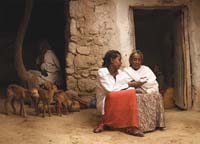
Counselling is not advice — it is a helping process in which people are helped to make choices. Advice on the other hand is usually based on opinions or suggestions about what could be done about a situation or problem. It is an opinion given by someone who is considered to be an expert. With advice, the decision is made by the health worker — and then the clients are expected to follow that decision. In counselling, the decisions are made by the clients themselves.
Before you read any further, ask yourself why you think advice might not be appropriate in health counselling?
There are two main reasons. First, if the advice is right the person may become dependent on the expert for solving all their problems in the future. Health education work in general and counselling in particular aim to help people to become self-reliant. Second, if the advice turns out to be wrong the person will become angry and no longer trust the health worker.
You may be able to use counselling to help individuals think about their problems and help them gain greater understanding of the issues. There are several clear steps in the counselling process:
- Helping the person to identify his or her problem
- Helping the person to discover the cause of the problem
- Encouraging the person to look at several possible solutions to the problem
- Encouraging the person to choose the most appropriate solution.
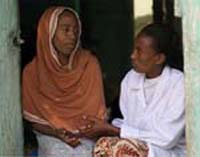
During your counselling work as a Health Extension Practitioner you will need to develop some rules and follow certain principles of counselling. Of course, counselling can’t do everything for everyone, and you need to recognise your own limits and the limits of the counselling process.
You must always make sure that it is the person who needs help who makes the final decisions about their own lives (Figure 11.3).
You should always ensure confidentiality and tell the truth, even if that is difficult. Confidentiality and truth-telling are two of the ethical principles covered in detail in the Module on Health Management, Ethics and Research.
Box 11.1 gives some of the most important rules to keep in mind for counselling.
Box 11.1 Rules for counselling
- Good relationships: A counsellor must build a good relationship from the beginning with the person they are trying to help.
- Feelings: A counsellor should develop empathy (understanding and acceptance) for people’s feelings, not sympathy (sorrow or pity). The counsellor’s task is to listen carefully. Empathy is the ability to imagine yourself in someone else’s situation so you can get a better sense of what they are feeling and experiencing. It involves understanding the client’s verbal and emotional behaviour. It requires comprehending another person’s feelings, emotions and perspective, rather than imposing your own.
- Identifying needs: A counsellor seeks to understand a problem as the client sees it from their point of view. The clients must identify their own problems for themselves. The use of open questions will help here, not just those questions requiring a yes or no answer.
- Participation: As a counsellor you should work with the clients towards finding their own solution. A counsellor should never try to persuade people to accept their advice.
- Privacy and confidentiality: Information that you might gather during your work, especially during counselling, must be kept secret from all other people, even from the client’s relatives. The places where you do counselling should be arranged in such a way that noone can listen to your private discussions.
- Provide information: Although counsellors do not give advice, as a health worker you should share information and ideas on resources which the clients may need in order to make an informed decision.
Based on what you have read so far, write down briefly what you think counselling aims to achieve.
Counsellors encourage people to recognise and develop their own coping capacity, so that they can deal more effectively with problems. In counselling, you not only help people think clearly about their immediate problems, you also help them to recognise and draw upon their own resources, which they can use for resolving the future problems they encounter.
Counselling is about creating new perspectives and change. The change may be inside the person (helping them to feel differently about a situation); or a change in their behaviour (for example practising safer sex), or a change in something in their environment (for example setting up a support group).
11.1.1 Qualities of a good counsellor
Some qualities that a good counsellor needs to have include respect for the dignity of others, and to have an open or non-judgmental attitude, as well as being empathetic and caring, knowledgeable, honest and sensitive. You will also need to develop self-discipline and learn the skills to become an active listener. To be an active listener as a counsellor you will have to avoid jumping to conclusions about what the client is saying. Box 11.2 presents some other things a counsellor should avoid.
Box 11.2 Things a counsellor should avoid (pitfalls)
- Directing and leading the ideas of the clients
- Moralising, preaching and patronising
- Judging and evaluating the clients
- Labelling and diagnosing the client’s problems
- Unwanted reassurance
- Not accepting the client’s feelings
- Interrogating (aggressive questioning) the client
- Encouraging dependency
- Advising the client rather than helping them come to their own conclusions.
Knowing what makes a poor counsellor is another way of building up your idea of what counselling is. Look at the pitfalls of counselling in Box 11.2 and try writing another phrase by the side of each pitfall which sums up an aspect of good counselling.
Table 11.1 suggest some phrases, but you may have thought of others.
| Pitfalls for counselling | Alternative phrases for good counselling |
|---|---|
| Directing and leading the ideas of the clients | Helping the client come to their own decisions |
| Moralising, preaching and patronising | Respecting the views of the client |
| Judging and evaluating the clients | Not being judgemental or evaluating the clients |
| Labelling and diagnosing the client’s problems | Being open to the way that the client expresses their problems |
| Unwanted reassurance | Not saying that everything will be alright — unless you are sure that it will be |
| Not accepting the client’s feelings | Accepting the client’s feelings |
| Interpreting the client | Gentle questioning is more effective than making interpretations |
| Encouraging dependency | Encouraging the client to see that ‘soon you won’t need me anymore. You will be able to sort out your problems by yourself’ |
| Advising the client rather than helping them come to their own conclusions | Explaining to the client that ‘I can’t tell you what you should do. I’m sure that you will make the correct decision’. |
11.2 Approaches to counselling
Some counsellors use the ‘GATHER’ approach to counselling and find it effective. You should read this next section and think how you will be able to use these points in your own work.
- Greet the individual people you are working with by name: show respect and trust, tell them that the discussion is always confidential.
- Ask about their problems as well as listening to any measures they have already taken to solve the problem. Ask them how they believe that you can help them.
- Tell them any relevant information that they need to know.
- Help them to make their own decisions and guide them to look at various alternatives. Help them to choose solutions which best fit their own personal circumstances.
- Explain any misunderstandings. Ask some questions in order to check your understanding of important key points and repeat those key points in their own words if necessary.
- Return for follow-up and make arrangements for further visits, or referral to other agencies. If a follow-up visit is not appropriate then you should give them the name of someone they can contact if they need help.
Box 11.3 is a tick list you can use while you are following the GATHER approach:
Box 11.3 Tick list for counselling
| Use simple language avoid any technical words. | ✓ |
| Make your advice as simple and specific as possible. For example, instead of saying ‘Practice good hygiene’ you could say, ‘Wash your hands before preparing your baby’s food’. | ✓ |
| Give information in organised ways — for example, I am going to tell you three things: the first is… the second is… and the third is … | ✓ |
| Give the most important information first and repeat it at the end. | ✓ |
| Check whether the main points have been understood by the person you have been counselling. | ✓ |
| Provide reminders (for example leaflets or other health education resources with key points) for the person to take away. | ✓ |
Mrs Aster is a Health Extension Practitioner. She is working in Adame Tulu kebele. On her home visits, she gives counselling to married women about how to prevent unintended pregnancy. How could she use the GATHER approach during her counselling work?
First she should greet the individual clients by name (G), then ask about their problems as well as listening to any measures they have already taken to solve the problem (A). She should tell them any relevant information that they need to know in order to help them to make a decision (T) and help them to look at the various alternatives (H). Then she should explain any misunderstandings that have occurred (E). The client should be encouraged to return for follow-up and to discuss any other issues that arise (R).
11.2.1 Places to conduct counselling
Home visits can become one of the best opportunities for counselling with individuals and with their families. Health workers will be able to visit all homes in their communities regularly, especially if there are significant problems that have been identified.
Home visits are important to understand the real background of families, their living conditions and the environment in which they live (Box 11.4).
Box 11.4 The purpose of home visits
- Establish rapport — make and keep good relationship with families in the community
- Detect and try to improve troublesome situations at an early stage
- Follow-up opportunities — checking the progression of sick people
- Educate the family on how to help a sick person
- Observe the environment and the behaviours that affect the health of the family
- Identify barriers to possible behavioural change
- Provide health education whenever possible
- Inform people about important community events in which their participation is needed.
- Appreciate the fact that people may feel free to talk more openly with health providers when they are in their own homes.
Look at the list in Box 11.4 again and think carefully about why you think home visits are so useful. Pick out one point on the list which you think is particularly linked with the home environment.
Point 5 is very important. In someone’s house you can see how they live. As a Health Extension Practitioner you can observe people and what the factors in their home life are. Clearly point 9 is also very important. When people are in their own home they will feel more secure. People are usually more willing to talk when they are in their own homes than when they are at the clinic. At the clinic they may fear that other people will see them or overhear the discussion. They may be more honest and disclose more at home, because they feel safer. Nutrition demonstrations, for example, may be more useful if done in a person's own home. There the health worker will be able to use the materials and facilities that the person will be familiar with. This will make the demonstration more realistic and make their learning more effective (Figure 11.4).
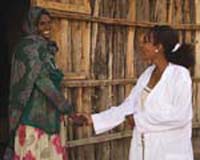
11.3 Health education with groups
Group health education may be a useful way to help you deliver your health education messages in an efficient manner. The group can provide support and encouragement to its members so they are able to maintain healthy behaviour. A well-organised group permits sharing of experience and skills so that people are able to learn from each other. This makes it possible to pool the resources of all members. Examples of positive group activity to resolve problems could include:
- One farmer may not have enough money to buy a vehicle to transport his produce to market, but a group of farmers together could contribute enough money to meet that need.
- Members of a group can give money, labour or materials to one of their members in times of personal or family crisis. They can also give support to the promotion of community health through projects such as developing a safe water supply or building a latrine.
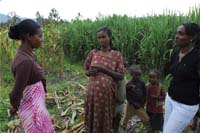
Ms Genet has planned health education activities on malaria prevention methods for groups within the Gingo kebele community. Ms Genet delivers health education sessions effectively and one of the main components of her plan is group work. What do you think may be the reasons for her choosing group work in the community?
The effectiveness of the health education given by Ms Genet to community groups might be because groups provide support and encouragement to their members. The groups may be able to help each other maintain healthy behaviour and share their experience and skills (Figure 11.5).
11.3.1 Group dynamics
Observing group dynamics tells us what is happening among the group members and in the group itself. The effectiveness of group functioning depends on several different factors including the following.
Size of a group
Many people feel that 8–12 is the ideal size for a group, but really it depends on the aims and purpose of the group. The larger the group, the less contribution individual members are able to make — and poor decisions may be the result.
The background of group members
Who the group members are and their reason for attending will also determine the group dynamics (Figure 11.6). If the members are sent by their employers to attend they may not be interested and may consider that having to attend the group is a form of punishment.
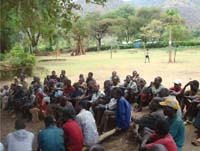
The nature of the task
The extent to which the task is concerned with producing results, or alternatively, with promoting the wellbeing of the members of the group, will change the nature of each group.
Group decision-making
Decision-making depends on the complexity of the decisions taken and the range of skills and expertise in the group. The ways of reaching decisions in the group will also affect the group dynamics. Decision-making can be through consensus, which involves everyone’s agreement, or through voting, in which case decisions will be decided on a majority vote.
Think of a group in which you have recently been involved (it doesn’t need to be a health education group). Look again at the three factors affecting group dynamics above and write down how each item affected the group that you were involved in.
We cannot know what your answer is to this question, but we hope that it has helped you use your own experience to begin to think about how groups work. You may have noted that a large group tends to ‘lose’ the contributions of individual members, and perhaps gives a chance for one unhelpful person to dominate proceedings. Were you able to identify the task clearly? Perhaps you noted how decisions were reached — again there are differences between small and large groups. Better decisions are often reached in smaller groups.
Individual roles of members
Within each group there will be a range of individual personalities. Some people will be helpful, while others are disruptive or shy. After a short time of working with the group you will begin to recognise the patterns of each person’s individual behaviour and how they all function together as a group.
Pattern of leadership
How well a group performs often depends a great deal on the quality of the leadership and the leadership style used by the leader.
There are three main styles of leadership that you might recognise:
- In the authoritarian approach the leader is the only person to decide about issues for the group. He or she might say something like, ‘I am in charge’. This style will often reduce creativity of the other group members and limit the output of the group.
- A leader using the democratic approach consults the group to make decisions. He or she might say something like, ‘Let’s all try to work out what will be the best approach’. This style is where the leader acts as a facilitator and helps everyone to work together. But when it becomes necessary they can provide a stimulus to action if the meeting is stuck and failing to reach a decision.
- ‘Laissez-faire’ literally means ‘to leave to do’, or to do nothing. This style of leader may say something like, ‘Do whatever you want’. If a group leader does not use their role effectively as leader the entire group may become very disorganised and inefficient.
On the whole, if you were to be a group leader, which style of leadership do you think might work best in the field of health education?
Health education with groups seems to work well with participation so the democratic approach — where things are worked out together with the leader acting as facilitator — may well be the most effective approach.
So, it is important to think about your own role as a group leader in the future and how you might best lead health education groups.
11.3.2 Group functions
In most groups you will be able to see that there are three important group functions: group building, group maintenance and task maintenance.
Group building functions
At the start of any group there are many possible ways in which it could be established. For appropriate group building you may have to consider the selection of group members and how the individual members should be recruited. Before the group starts you will have to arrange the physical environment and provide any necessary equipment. When people first arrive for the group meeting you should attend to the introduction of members to each other, before electing a leader and reporter (or note taker) for the group. At the first session it is really important to make clear what the functions of the group will be, and explain the purpose and goals of the group in the future.
Group maintenance functions
To keep the group running smoothly it is important to use encouraging words towards the group members. You might say, ‘Your suggestions are very important’. If tensions arise you may have a role in mediating or making compromises to help the functioning of the group. In relieving tension it may be appropriate to lighten the discussion by talking about things on which there is agreement — or even making jokes if this is appropriate. If some people dominate the group you may have to take a little more control and ensure that every member of the group can have their voice heard.
Task maintenance functions
To keep a group running smoothly and making progress towards its objectives there are many different functions that you should consider. You may have to initiate things within the group and bring new ideas and creativity to the sessions, or invite other group members to do this. Leaders of a group should also be able to look for information from different sources, including from other group members. It may be necessary to clarify or elaborate on specific issues as the group progresses. Throughout the group sessions it will be important to coordinate its activities and summarise how much progress has been made at the end of each group session.
Think again about the group you used as an example in the previous activity. What were each of these functions for that group?
Did you think about the physical setting of the group? Did that work well? And was there a clear message at the beginning of the group about what the goals of the group were? How were the workings of the group controlled? Were people’s contributions valued? Was the progress of the group remarked on? Did people know where they had got to?
Of course, not all group work goes smoothly (Figure 11.7)!
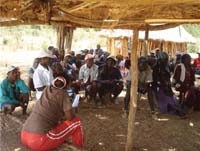
Conflict resolution
Disagreement as a result of differences in opinions and views on issues is a frequent occurrence in groups. Sometimes it may be useful to think about how differences or conflicts could be resolved in any groups that you are responsible for running. Successful groups have conflict resolution mechanisms, both formal and informal, for dealing with differences — otherwise the disagreements could lead to poor group interactions or poor performance, or the group disbanding altogether.
No two groups are the same and this is the interesting thing about establishing various groups for your health education activities. You will soon become experienced in handling groups and using them to improve the health of your community. Each individual will bring something important to the group and it is your role to make the best of the contributions that everyone is able to make. However not everyone behaves in the same way when they are members of a group, as Box 11.5 illustrates.
Box. 11.5 Types of group behaviour
Helpful behaviour:
Making suggestions, encouraging each other to talk, responding politely to the suggestions of others, helping make points clear, giving information, showing concern for each other, volunteering to help with work, attending meetings regularly and on time, and thanking each other for suggestions given.
Non-helpful, non-functional behaviours:
- Blocking: interfering with group process, diverting attention by citing personal experiences unrelated to the problem, disagreeing and opposing a point without reason. Arguing too much on a point that the rest of the group has resolved and rejecting ideas and preventing a decision.
- Aggression: blaming others, showing hostility.
- Seeking recognition: calling attention to oneself by excessive talking and boasting.
- Withdrawing: becoming indifferent or passive and whispering to others.
- Dominating: excessive manipulation or authority and interrupting or undermining the contribution of others.
Some identifiable types of behaviour are set out in Box 11.5. Read carefully through the material in the box and think back to groups that you have been a member of. Can you think of specific people who have behaved in the ways detailed in the box? How do you behave yourself when you are a member of a group?
We cannot know what happened in your group, but as a Health Extension Practitioner you must become skilled at encouraging helpful behaviours and at controlling unhelpful behaviours. Observing groups is an important component in learning and maintaining these skills.
11.4 School health education
School health education involves instructing school-age children about health and health-related behaviours. It is an important branch of community health and must be based on the local health problems of the school child, the culture of the community and available resources.
Comprehensive school health education is a sequence of learning experiences that enable children and young people to become healthy, effective and productive citizens. It includes a list of topics such as personal, family, community and environmental health, comprehensive sexuality education, mental and emotional health, injury prevention and safety, nutrition, prevention and control of disease, and avoidance of alcohol, tobacco, and other drugs.

Good health is the foundation for academic success (Figure 11.8). Children who face violence, hunger, substance abuse, unintended pregnancy and despair cannot possibly focus on academic excellence. School children spend a significant proportion of their time in the school environment and there is a potential for the occurrence and spread of communicable diseases that needs to be addressed. The school health programme is an opportunity for the healthcare system to include young members of the community in the objectives of their health programmes (Box 11.6).
Box 11.6 The objectives of comprehensive school health education
- To maintain and improve children’s health and the promotion of positive health
- To facilitate early diagnosis, treatment and follow-up of health problems
- To prevent disease
- To avoid or reduce health-related risk behaviours
- To improve student achievement through health knowledge and improving health skills and behaviours
- To protect and promote the health of staff
- To promote a safe and healthy school environment.
11.4.1 The role of Health Extension Practitioners in the school programme
The role of the Health Extension Practitioner includes being a care provider health educator, consultant, and counsellor. She collaborates with students, parents, administrators, and other health and social service professionals regarding a student’s health problems. Thus, you need to be knowledgeable about the area and local regulations affecting school-age children, such as rules for excluding students from school because of communicable diseases, or parasites such as lice or scabies.
The Health Extension Practitioner is also a health education consultant for teachers. In addition to providing information on health practices, teaching health classes, or participating in the development of the health education curriculum, the Health Extension Practitioner educates the teacher and class when one of the students has a special problem, a disability or a disease such as acquired immunodeficiency syndrome (AIDS).
Why should you carry out comprehensive school health education in school settings?
The purpose of carrying out comprehensive school health education is to maintain and improve the health of school students (Figure 11.9), and make sure that ill health doesn’t affect their development or their school achievement. Look back at Box 11.6 for the details of the range of health education activity which is important in schools.

Summary of Study Session 11
In Study Session 11, you have learned that:
- Counselling is one of the approaches most frequently used in health education with individuals. Counselling means providing a choice for the individual who has a problem. During counselling the client will not be given advice or forced into a decision. Establishing a good relationship with the individual is vital to successful counselling.
- In your group work you may use formal or informal groups to put across your health education messages. Formal groups usually have a purpose or goal that everyone in the group knows, accepts and tries to achieve by working together. Members of the group may feel a sense of belonging and welcoming.
- Informal groups may still provide the opportunity for you to do some health education work, although they may have less of a feeling of belonging and less of a common interest amongst the group members.
- When working with your various health education groups you will be aware of the group dynamics that govern the functioning of all groups.
- School health education is any combination of learning experiences initiated by Health Extension Practitioners in the school setting that can develop the behavioural skills required to cope with challenges to health.
Self-Assessment Questions (SAQs) for Study Session 11
Now that you have completed this study session, you can assess how well you have achieved its Learning Outcomes by answering these questions. Write your answers in your Study Diary and discuss them with your Tutor at the next Study Support Meeting. You can check your answers with the Notes on the Self-Assessment Questions at the end of this Module.
SAQ 11.1 (tests Learning Outcomes 11.1 and 11.2)
Explain the difference between counselling and advice, and give examples of each of them.
Answer
Counselling is a helping process where one person explicitly, and purposefully, gives their time to assist clients to explore their own situation, and act upon a solution. It is the process by which we first understand the problem, and then help the client to understand their problem, and then we need to work together with them to find a solution that is appropriate to their situation. It involves helping people to make decisions and giving them the confidence to put their decision into practice.
Advice is based on opinions and suggestions about what could be done about a situation or problem. It is an opinion given by experts on what to do and how to do it. In advice, the decision is made by the health worker and the clients are expected to follow the decision. But in counselling, the decisions are made by the clients themselves.
Advice is not appropriate in health counselling for two reasons. First, if the advice is right, the person may become dependent on the counsellor for solving all their problems in the future. Second, if the advice turns out to be wrong, the person will become angry and no longer trust the counsellor.
SAQ 11.2 (tests Learning Outcomes 11.2 and 11.3)
Counselling is all about dealing with problems. Write down a brief description of what you think counselling is, and list the four key stages you can use when working with problems.
Answer
Counselling helps an individual to think about their problems and thus encourage them to develop a greater understanding of their problems. They are then in a position to look for possible solutions and be able to take action.
The four key stages in counselling are:
- Helping the client to identify their problem
- Helping the client to discover the cause of the problem
- Encouraging the client to look at possible solutions to the problem
- Encouraging the client to choose the most appropriate solution which best suits their circumstances.
SAQ 11.3 (tests Learning Outcomes 11.4 and 11.5)
Which of the following are not elements of group dynamics, and which are factors affecting how a group functions?
- Size of the group
- Leadership patterns
- Lecturing
- Administering surveys
- Individual role contributions
- Decision-making
- Needs assessment.
Answer
Items 3, 4 and 7 are all related to health education, but they are not elements of group dynamics. Group dynamics tells us what is happening among the group members or in the group itself. The effectiveness of group functioning depends on several different factors including items 1, 2, 5 and 6: the individual roles of members, the size of the group, the background of the group members, the nature of the task, group decision-making and the pattern of leadership.
SAQ 11.4 (tests Learning Outcome 11.6)
Why do you think health education in schools is so important? List at least three reasons.
Answer
Good health is the foundation for academic success. Children who face violence, hunger, substance abuse, unintended pregnancy and despair cannot possibly focus on academic excellence.
School children spend a significant proportion of their time in the school environment and there is a potential for occurrence and spread of communicable diseases that needs to be addressed.
The school health programme is an opportunity for the healthcare system to include young members of the community in their health objectives. It models the importance of health education at an early age.